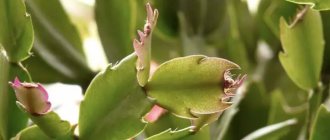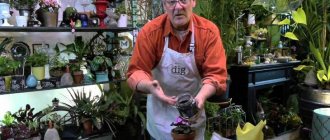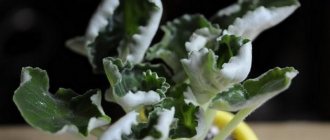Perhaps every beginner is familiar with the following situation. As soon as the violets have babies, they immediately try to separate them and root them in a larger container. However, there is absolutely no need to rush here. Because it can harm the plant. You need to wait until up to 4 leaves are formed and only then transplant. We will consider the remaining nuances below.
What is it and how is it different from the starter?
A baby is a small plant, which was separated from the mother bush 5-6 months after the cuttings took root.
The starter is a violet in which there is a transition between a baby and an adult flower. They already have rosettes with up to 15 leaf blades and a developed root system.
Which violet is called a starter?
The starter violet is not a variety or subspecies of the plant, it is a flower ready to bloom, and close in age to a young adult violet. It takes 8 months to raise a baby starter. This will be followed by the adult violet stage.
Flowering conditions
Before purchasing a plant, you need to know how to care for it. These flowers are considered capricious, but this is not so. With proper care, the plant will delight the eye with flowering almost all year round.
The consistency and splendor of violet flowering is determined at the genetic level, so it is important to choose the right variety and provide the flower with proper care.
To do this, you must follow the following rules:
How to replant a baby violet
To understand how to plant violet children correctly, you should know what methods exist:
- Complete replacement of the substrate. Required when the crop is over or soil depletion is observed.
- Partial replacement of the substrate. Performed when purchasing a new variety or when the old container has become small.
- Transshipment during the flowering period.
Determining a favorable moment for separation
You can understand when to replant a violet baby by the following sign: each baby has 2 to 3 pairs of leaf blades. If this has a place to be, then you can safely separate the children and root them. Initially, plastic glasses are chosen for this.
What is a cutting, baby, starter, adult plant (stages of the violet life cycle)?
In the 2014 season, I am often asked the question of what “cutting”, “rooted cutting”, “baby”, etc. means. Probably, newcomers have arrived in the violet regiment) Therefore, so as not to have to explain the meaning “on fingers” every time each term, I decided to write this article.
So, most often new violets are obtained from leaves, that is, cuttings. An unrooted, freshly cut cutting/leaf is a leaf that has just been cut/broken off from the plant. Shipping is best tolerated.
Usually, after breaking, the cut is made obliquely. So, according to my observations, we get a good root system and healthy, strong children.
Next, such a freshly cut cutting should be rooted. Some collectors immediately sprout leaves in the ground. I always do this in the water. That is, I put it in water and wait for the roots to appear.
When the roots have appeared, the leaf can be planted and placed in a greenhouse for several weeks. I usually keep it in the greenhouse for 1-2 weeks. After which I take out the leaf - it has not yet grabbed the ground so tightly, but is already quite viable. I immediately put it on wick watering and soak the earthen ball well. And so several more weeks pass until the leaf is completely mastered, becomes independent, strong, tenacious.
And then its state is called a rooted leaf . That is, a leaf that grows independently without a greenhouse, is viable and stress-resistant.
Just a little time passes - and such a leaf gives birth to children en masse. The rooted leaf with children enters the phase . The children grow up next to their mother until it is time to leave them. Usually there are 4-6 young leaves, the leaf blade of which is the size of a marigold.
Baby violet is an independent small plant. It has its own root system, lives independently without a greenhouse, and has taken root well.
Children come in different sizes, depending on their age and maturity.
With mini-violets, the situation regarding breeding/reproduction is the same as with standards. The difference is their size.
There is also a method of breeding - like the stepson of violet . This is when a small shoot appears in the axil of the leaf.
Chimeras and multi-colored (complex fantasy varieties) are especially propagated by stepchildren. To better convey their varietal characteristics. Well, not on purpose - all violets quite often take stepson. Especially before flowering. Usually, it is best to carefully remove stepchildren with a wooden toothpick at the earliest stages. Since, growing, they deform the rosette. The main thing is to distinguish the stepson from the stipules on the bud.
If there is a need, a well-formed stepson can be separated, planted and a violet can be grown from it.
Growing up, the baby turns into a starter. The starter is a teenage plant, young, but already closer to an adult violet. The next stage is the young adult violet. On the left is a starter, on the right is a young adult violet.
A little more time passes - and the violet begins to form buds. It enters the stage of violet with buds, violet on buds .
Of course, the most exciting thing is to wait for the violet to bloom and the buds to open. Watch how every day the plant blooms more and more luxuriantly, gaining a head of flowers. )
From the beginning (cutting the cutting) to the end (flowering of the plant), the entire growing procedure takes approximately 1 calendar year.
Then the plant can be replanted, rejuvenated, prepared for the next, more mature and colorful flowering... But this is a topic for another article)
Features of violets in raising offspring
The peculiarities of raising children in violets can be encountered only in variegated varieties. This is due to the fact that the color of their leaves is not uniform. The plant grows a large number of chlorophyll-free leaves that lack the green fragment. They cannot be replanted, even if there is not enough space in the container - they will die, as they feed from the mother bush.
How long does it take to appear?
To begin the development of children, it is necessary for the mother’s leaf to take root well and begin to nourish the offspring. This process takes about 2-3 weeks. Usually you have to wait at least a month for the first young rosettes to appear. If the cutting has not produced offspring two months after it was planted, there is no point in expecting it. Experienced flower growers in such cases proceed in two ways: either cut off this leaf again and root it in the ground, or remove a third of the leaf plate so that the mother plant can direct more energy to the development of the root system and children.
Preparatory stage
At the preparatory stage, it is recommended to prepare everything that will be needed in the process of rooting violet babies. Namely, they choose a suitable nutrient soil or prepare it themselves and purchase pots for replanting.
Priming
The substrate does not require preliminary preparation. You can also prepare it yourself. To do this, take chernozem and peat in proportions of 5:3. You also need to add one part of coarse river sand. A prerequisite for preparing the soil yourself is to warm it thoroughly or pour it with a solution based on potassium permanganate.
Capacity
The choice of container size directly depends on the age and size of the plant itself:
- For healthy violets, select containers 10 cm high. The width should be 3-5 cm larger than the old pot.
- Transplanting baby violets with bare stems should be done in a high pot. In this case, the stem should be covered with soil up to the first leaf blades.
- For young rosettes, choose pots with a diameter of up to 6 cm.
- Sick violets are transplanted into the same pots.
Tools
To separate the children and from further rooting, the workplace should not be cluttered. It is most convenient to perform all actions at the table. To work you will need the following tools:
- Scissors or a sharp knife.
- Brush. It is used to cleanse the root system.
- Toothpicks.
What it is?
Indoor violets are propagated at home by cuttings and subsequent rooting of the cut leaf. To do this, select a strong and healthy leaf from an adult plant and separate it. The cut cuttings are placed in a small container with water until roots appear or immediately planted in the ground.
A violet baby appears from a transplanted cutting that has taken root in a new place. Small leaves begin to appear from the soil next to the stem of the established leaf. These are the kids. Each cutting can produce a different number of small shoots. The number of young rosettes depends on the violet variety and growing conditions. Under the most favorable conditions, the cutting can produce up to 7-8 new rosettes.
Each baby has its own root system, which allows these young plants to be transplanted into separate cups and pots.
Depositing technology into a separate container
The starter is transplanted according to the following step-by-step algorithm:
- Prepare a pot for growing the crop. Drainage is poured, the layer of which is up to 1.5-2 cm. A small mound of substrate is poured in the center.
- The violet is carefully removed from the plastic cup. Everything is done carefully so as not to damage the root system. Excess soil is removed by hand.
- The starter is placed in the container so that the lower leaves are below the edge of the pot.
- The root system is carefully distributed along the bottom of the container and covered with substrate on top. The center of the socket should not be recessed.
How to avoid being sprinkled with stepchildren?
A stepson is a daughter rosette of a violet that grows in the axils of the foliage of the mother rosette, and sometimes at its base. The growth of stepchildren is a natural process.
If there is no goal to propagate the variety in this way, then it is better to remove them, because they take power from the mother’s outlet. But they should be carefully examined so as not to be confused with a nascent bud.
Daughter rosettes are removed in any convenient way: with a toothpick, scalpel, cuticle knife, etc., but flower stalks will not form in their place.
The main reason for the appearance of young shoots is fertilizer with a high nitrogen content, sometimes this is influenced by diseases or plant variety.
To avoid stepchildren, you need to carefully examine the mother sockets and remove the daughter ones. After the first flowering, Saintpaulias shoot much less.
Transplantation and care
The moment for transplanting teenagers comes when the root system completely entwines the earthen ball .
Then there is no need to postpone replanting or transshipment of the plant, since it is in an active stage of growth. And a children's pot with a poor soil composition only inhibits the growth of Saintpaulia. If you look closely at the violet, you will see that the bottom row of leaf blades has a different shade than the rest of the plant. The fact is that harmful substances accumulated during flower growth are deposited there.
On the other hand, when the starter no longer has enough nutrients or water due to the small volume of the cup, the lower leaf blades give up their resources to the young leaves.
There are two ways to move the violet to a larger pot :
In the case of replanting a teenager , you can change the main principle of selecting a pot for a plant, that is, take a container not 1/3, but 1/2 of the diameter of the outlet.
For starters, take pots half the diameter of the rosette.
The soil mixture is prepared with a higher organic content than when planting children. But overfeeding with nitrogen is not recommended; this leads to thickening of the center of the rosette and loss of immunity. Before use, the substrate should be slightly damp, but not wet.
2-3 days before moving the violet, it must be watered and the bottom row of leaves removed , even if they have not changed their color. After transplanting or transshipment, these leaf plates will still wither and will have to be removed.
The starter is transplanted using the following technology:
- Pour 1-1.5 cm of drainage into the prepared pot and a little prepared soil with a mound in the center;
- Lightly knead the glass with the teenager with your fingers so that the violet can be easily removed;
- Carefully free the roots from the old soil by shaking; no need to wash them under water;
- Place the starter in the center of the pot so that the bottom row of leaves is slightly below the rim of the container;
- Distribute the roots inside the container, carefully fill the soil, preventing the center of the outlet from going deep.
When transplanting, the roots are freed from the ground.
For the first 2-3 days, do not water the transplanted violet , since the tender roots damaged during transplantation can easily rot and destroy the entire plant. This is why it is safer to reload starters rather than replant them.
The transfer of Saintpaulia follows a similar scenario:
- Pour 1-1.5 cm of drainage and a little prepared soil into the prepared pot; there is no need to add a mound;
- Place the same cup as the plant being transplanted in the center of the container and fill the gap between the walls with soil. It needs to be compacted a little so that when the glass is removed the substrate does not crumble;
- Lightly knead the glass with the plant with your fingers so that the Saintpaulia can be easily removed;
- Place the earthen ball with the violet in the recess of the pot so that the soil levels coincide.
When transshipping, the old earthen lump is not touched.
With this planting method, the roots are not injured, the starter recovers faster from stress and begins to grow. After transshipment, the plant can be lightly watered with Zircon solution.
What is violet-sport - all about Saintpaulia-sports
What is violet-sport - all about Saintpaulia-sports
Post by OlgaLR » 04 Aug 2009, 21:31
When you grow Saintpaulia from a leaf, is it called sport? And is it different from the original? Now I’m growing five leaves myself, it’s interesting.
What is violet-sport - all about Saintpaulia-sports
Post by sirit77 » 04 Aug 2009, 22:15
What is violet-sport - all about Saintpaulia-sports
Post by Edith » March 20, 2011, 8:47 pm
What is violet-sport - all about Saintpaulia-sports
Post by Lucina » March 20, 2011, 8:54 pm
What is violet-sport - all about Saintpaulia-sports
Post by Edith » March 20, 2011, 8:57 pm
Why do violet leaves grow downward?
Improper watering leads to problems with roots. If the soil is too dry, thin roots die, which leads to the fact that the root system cannot absorb water. In both cases the leaves
droop and lose turgor. ...
Interesting materials:
What density should insulation be for the walls of a frame house? What is the wire from the pole to the house? What is the safest heater for your home? What is the cheapest house to build? What's the cheapest house? What kind of crushed stone is needed for the blind area of a house? What kind of SIP is needed for a home? What layer of insulation is needed for a frame house? What is the validity period of a permit to build a private house? What is the service life of a house made of sip panels?











